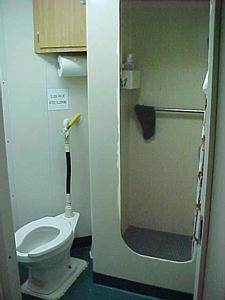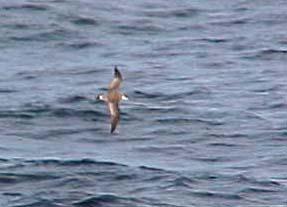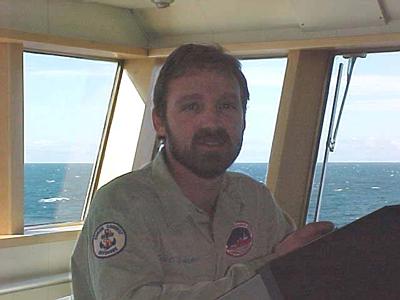5 March, 2000
Leaving land behind; Interview with Captain Warren
Question 15: What separates the Southern Ocean from the Atlantic, Pacific and
Indian Oceans?
Late last night the Gould left the Strait of Magellan and headed south
towards the tip of South America. Around noon today we will travel between
Tierra del Fuego and Isla de los Estados (States Island) in Marie Strait, then
leave land behind for a few days. It is another beautiful day. When we
reached the end of the last strait, brown mountainous land was clearly visible
on both sides. There are Greater and Sooty Shearwaters dodging gracefully
around the waves. They beat their wings for a bit, then glide along the
surface. We also have seen Black-browed Albatross cruising past the boat;
they are not such confirmed ship-followers as the Wandering Albatross which we
should see once we are out in the Drake Passage. All of these pelagic birds
are skillful at using their long narrow wings to make use of minute air
currents to skim the wave crests and troughs. "Pelagic" means having to do
with open ocean water and includes both surface and subsurface. It is usually
contrasted with the term "benthic" which means on or near the ocean floor.
After we said goodbye to land, I made my way up to the bridge. With only
about 35 people on the ship, passengers are welcome on the bridge at any time.
We just can't get in the way of the controls. Captain Warren was on the
bridge but not on watch. There are three mates who stand four-hour watches.
Their daily shift is four hours on, eight hours off. Watches are 12-4, 4-8
and 8-12. Captain Warren does not have a specific schedule, but he is always
on the bridge when the ship is near shore or during equipment problems or if
the seas are especially bad.
The back wall of the bridge has a display case with Coast Guard rating
certificates for many of the ship's personnel. Captain Warren explained that
he has two different types of Master's licenses. One is for a 1500-ton
vessel, adequate for the Gould which is officially 1499 tons. The other is an
Unlimited license which would allow him to captain a vessel of any size
anywhere in the world. He said that one of the things he likes most about his
job is that "anyone, male or female (although the crew was entirely male),
black or white" could go into it out of high school and get their Unlimited
Masters license in around 7 years.
There are several levels or ratings that everyone goes through. Moving on to
the next rating requires a certain amount of sea time as well as passing the
appropriate tests. There are also two different categories of licenses.
There are a variety of levels based on maximum ship tonnage that the license
would qualify someone to work on/operate--50 ton, 200 ton, up to 1500 tons.
Then there is the unlimited license. Most sailors getting into offshore
sailing work towards either a 1500 ton or an unlimited license. Many of the
mates on board the Gould have ratings in both.
To become a captain, someone would first spend time on the deck crew. The
next step is mate. There is only one level of mate for all licenses except
unlimited. On an unlimited license track there are Third, Second and First
Mates before someone reaches his or her Masters rating. Captain Warren
estimated that it takes between one and two years to go between rating levels,
primarily dependent on how much of that time was spent at sea. He knows
people who have gotten the requisite number of hours in as little as seven
months.
For those curious souls who asked, the bathrooms on board the Gould are not
much different than ordinary US bathrooms. All staterooms have their own;
there are also several public use ones on each level. Our bathroom door has a
holdfast it attaches to if we want to keep the door open. It has a perfectly
normal sink, mirror and lighting. The only difference here is that instead of
a shelf to put stuff on, there is a metal tub over the sink to hold things
(also one of these in the shower for bottles). The shower has a railing on
three sides of the interior to grab onto and heavy-duty, rubber, lattice
matting for maximum traction while allowing for water drainage. The fourth
wall of the shower has an eight-inch lip around the sides and bottom to keep
water from sloshing out. When the ship starts moving more extremely, water
backs up in the bottom of the shower because it is over the drain for only a
short period of time as it sloshes from one side to the other. Again because
standard plumbing depends on a stationary gravitational pull to work properly,
none of the toilets have tanks. Instead of a flush handle there is a valve
handle that, when pulled, puts a large amount of water straight through the
toilet bowl down the hole. No chance for the water to fail to swirl in bad
seas.
Answer 14: Research Vessel.

A typical bathroom aboard the R.V. Gould.

Greater Shearwater.

Last view of South America, Tierra del Fuego.

The Captain

Contact the TEA in the field at
.
If you cannot connect through your browser, copy the
TEA's e-mail address in the "To:" line of
your favorite e-mail package.
|
